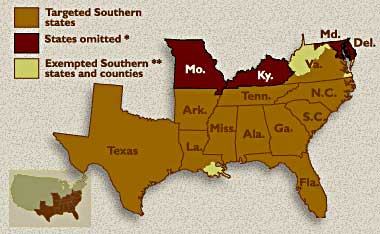—Kidada E. Williams
Eric Foner, in his 2011 Pulitzer Prize-winning book The Fiery Trial, described President Abraham Lincoln’s Emancipation Proclamation as one of the most misunderstood documents of American history. Many Americans hold it in the same esteem as they do the Constitution or the Declaration of Independence, but the actual document is rarely read and its context is far more complex. The Emancipation Proclamation will celebrate its 150th anniversary on January 1, 2013. As we approach its sesquicentennial, the time feels right to put the document and its impact into proper historical context.
Lincoln issued the Emancipation Proclamation as a military strategy for winning the war against the Confederate rebellion. By 1862, the war had been going on for longer than either the Union or the Confederacy expected. A number of Unionists concluded that taking away the Confederacy’s most valuable resource, their slaves, was the best way to cripple their ability to continue the fight. Some officials also wanted to arm enslaved black men and believed that the best way to obtain their loyalty to the Union was to free them and their families. As the chaos of war continued, the Lincoln administration searched for military solutions.
Although he was opposed to slavery, Lincoln was slow to use secession and the war to abolish slavery. He understood and respected that the Founding Fathers ensured that the Constitution protected slavery. In the face of mounting demands that he end slavery, Lincoln made clear that his paramount objective was to preserve the Union—the country established by the Patriots who rebelled against Great Britain—and not to destroy slavery.
Lincoln also knew that many white Unionists opposed increasing the size of the free black population for fear of economic and political competition. In his Second Annual Message he explained that a policy of wartime emancipation was the best way to win the war and preserve the Union. The next month, Lincoln used his power as the Commander-in-Chief during a time of armed rebellion to issue the Emancipation Proclamation.
It is important to understand what the proclamation did and did not do. It did not free all enslaved people. The proclamation did free enslaved people in states and parts of the states that were still in rebellion against the United States by January 1, 1863. That left more than 800,000 people legally enslaved.
Instead of being a panacea that destroyed slavery, the proclamation’s effect was quite limited. Confederates dismissed the proclamation, believing they could win the war and create their own slaveholding republic. Additionally, as historian James McPherson pointed out, the proclamation’s effectiveness was hindered by the fact that it could not be enforced in areas Union forces did not control militarily. The armies would not control the Confederacy until the war ends fifteen months later. In the end, the proclamation freed only some enslaved people, which is why Lincoln pushed Congress to pass the Thirteenth Amendment.
One under-appreciated feature of the proclamation is that it authorized the enlistment of African American men in the Union’s military forces. In 1861, when Lincoln called for volunteers to suppress the Confederate rebellion, many free black men answered. Lincoln refused their offer to serve because he believed that allowing them to fight might make people think that his priorities for the war had shifted from saving the Union to abolishing slavery. Down but not defeated, some black men continued to prepare for combat. As the war continued, Union forces suffered high casualties, and Lincoln moved closer to instituting a wartime emancipation policy, the president and others conceded that they should use black men in combat; he included that provision in the proclamation, which allowed roughly 185,000 black men to serve.
Civil War-era Americans’ reactions to the proclamation were mixed. Enslaved and free African Americans as well as white abolitionists were elated. More enslaved people who learned of the proclamation and could escape their masters to find Union forces did. Confederates, however, saw the proclamation as an attack on their very way of life, and it renewed their determination to fight. The Confederate Congress and Army responded further by instituting a policy that determined that any black soldiers captured by Confederate forces could be re-enslaved, enslaved (if they were already free), or executed.
As Gary Gallagher shows, many white Unionists supported the proclamation not because they opposed slavery but because they believed that freeing Confederates’ slaves was the fastest way to win the war. However, others worried about the larger social, economic, and political ramifications of ending slavery, namely sharing the benefits of American citizenship with people who they thought were inferior.
One key to understanding the mixed reactions to the proclamation is to remember that Americans during the Civil War knew that the proclamation did not end slavery or the war. The war continued until 1865 when the Confederates surrendered and slavery continued until the Thirteenth Amendment went into effect in December of that year.
Although the Emancipation Proclamation was a military document that had significant limitations, its political implications cannot be overstated. It marked the legal beginning of Americans’ effort to redeem the nation for what many people call the “original sin of slavery” and authorized the enlistment of black men to military service. The Emancipation Proclamation stands as a symbol of American freedom and deserves its place in the nation’s memory, right alongside the Constitution, Declaration of Independence, and Thirteenth Amendment.
Sources: Emancipation Proclamation Map: http://www.ushistory.org/us/34a.asp.
Kidada E. Williams is Associate Professor of History at Wayne State University and the author of They Left Great Marks on Me (NYU Press, 2012). You can find her on Twitter @kidadaewilliams.

